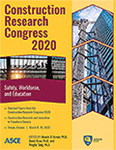Construction Research Congress 2020
Monitoring Fatigue in Construction Workers Using Wearable Sensors
Publication: Construction Research Congress 2020: Safety, Workforce, and Education
ABSTRACT
Fatigue on construction projects impairs worker efficiency, jeopardizes job site safety, and reduces productivity. This paper presents an innovative fatigue estimation approach that is based on the monitoring of worker heart rate and sleep quality time on construction sites using wearable sensors. An experimental test was developed to simulate a true construction activity. A Borg’s scale of 1 to 10 was used to estimate the fatigue levels of the participants in the experimental test. An experimental pilot study was conducted to monitor the heart rate and sleep quality for three participants using a fitness tracker. Classifiers, such as decision tree, support vector machine (SVM), were then trained using the fitness tracker extracted data. The results obtained showed that the polynomial SVM outperformed all other tested algorithms and was selected for further physical fatigue analysis. The accuracy of the fatigue prediction model was, respectively, 69.23% and 76.92% depending on using heart rate or both heart rate and sleep quality results.
Get full access to this article
View all available purchase options and get full access to this chapter.
REFERENCES
Albert, P.C. Chan et al. (2012), “Determining an optimal recovery time for construction rebar workers after working to exhaustion in a hot and humid environment”.
Abdelhamid, T.S. and Everett, J.G. (2002). “Physiological Demands during Construction Work.” J. Constr. Eng. M., 128(5), 427-437.
Aryal, A., Ghahramani, A., Becerik-Gerber, B. (2017). “Monitoring fatigue in construction workers using physiological measurements.” Automation in Construction. 82. 10.1016/j.autcon.2017.03.003.
Borg, G.A. (1982). “Psychophysical bases of perceived exertion”. Med Sci Sports Exerc., 14(5), 377-381.
Borg, G. (1990). “Psychophysical scaling with applications in physical work and the perception of exertion.” Scandinavian journal of work, environment & health. 16 Suppl 1. 55-8. 10.5271/sjweh.1815.
Chan, A., Yam, M. W.Y., Chung, J., and & Yi, W. (2012). “Developing a heat stress model for construction workers.” Journal of Facilities Management, 10, 59-74. 10.1108/14725961211200405.
Dement, W. C. (1997). “The perils of drowsy driving.”, Massachusetts Medical Society, The New England Journal of Medicine, 337, 11, 783-784.
Fang, D., Jiang, Z., Zhang, M., and Wang, H. (2015). “An experimental method to study the effect of fatigue on construction workers’ safety performance.” Safety Science. 73. 10.1016/j.ssci.2014.11.019.
Foster, C., Florhaug, J.A., Franklin, J., Gottschall, L., Hrovatin, L.A., Parker, S., Doleshal, P., Dodge, C. (2001). “Approach to monitoring exercise training.” J Strength Cond Res., 15(1),109-115.
Gatti, U., Schneider, S., and Migliaccio, G. (2014). “Physiological condition monitoring of construction workers.” Automation in Construction, 44, 227–233. 10.1016/j.autcon.2014.04.013.
Garet, M., Boudet, G., Montaurier, C., Vermorel, M., Coudert, J., and Chamoux, A. (2005). “Estimating relative physical workload using heart rate monitoring: A validation by whole-body indirect calorimetry.” European journal of applied physiology, 94, 46-53. 10.1007/s00421-004-1228-9.
Hwang, S., Seo, J., Jebelli, H., and & Lee, S. (2016). “Feasibility analysis of heart rate monitoring of construction workers using a photoplethysmography (PPG) sensor embedded in a wristband-type activity tracker.” Automation in Construction. 71. 10.1016/j.autcon.2016.08.029.
ILO (2005). “Facts of safety at work.” International Labor Organization <https://www.ilo.org/legacy/english/protection/safework/worldday/products05/report05_en.pdf>; (July 27, 2017).
Li, X., Komeili, A., Gül, M., and El-Rich, M. (2017). “A framework for evaluating muscle activity during repetitive manual material handling in construction manufacturing.” Automation in Construction. 79. 10.1016/j.autcon.2017.01.005.
Mitler, M.M., Carskadon, M.A., Czeisler, C.A., Dement, W.C., Dinges, D. F., and Graeber, R.C. (1998). “Catastrophes, sleep, and public policy: consensus report”, US National Library of Medicine, National Institutes of Health, <https://www.ncbi.nlm.nih.gov/pmc/articles/PMC2517096/>; (Aug 15, 2008).
OSHA (2010). “Construction Industry.” <https://www.osha.gov/doc/>; (Sep. 1, 2017).
OSHA (2015). “Commonly Used Statistics.” <https://www.osha.gov/oshstats/commonstats.html>; (Aug 1, 2017)
Parijat, P. and Lockhart, T.E. (2008). “Effects of lower extremity muscle fatigue on the outcomes of slip-induced falls.” Ergonomics. 51(12),1873–1884. 10.1080/00140130802567087.
Prittikangas, S., Fujinami, K., Nakajima, T., 2006. “Feature selection and activity recognition from wearable sensors”. In: International Symposium on Ubiquitous Computing Systems. Springer, 516-527
Powell, R. and Copping, A. (2010). “Construction worker sleep deprivation and its effects on personal safety.” Association of Researchers in Construction Management, ARCOM 2010 - Proceedings of the 26th Annual Conference.
Powell, R. and Copping, A. (2010). “Sleep Deprivation and Its Consequences in Construction Workers.” J. Constr. Eng. M., 136(10), https://doi.org/10.1061/(ASCE)CO.1943-7862.0000211
Powell, R. and Copping, A. (2016), "Measuring fatigue-related impairment in the workplace." Journal of Engineering, Design and Technology, 14(3), 507-525. https://doi.org/10.1108/JEDT-09-2014-0063.
Tanaka, H., Monahan, K.D., and Seals, D.R. (2001). “Age-predicted maximal heart rate revisited.” J Am Coll Cardiol., 37(1), 153-156.
Williamson, A.M. and Feyer, A.M. (2000). “Moderate sleep deprivation produces impairments in cognitive and motor performance equivalent to legally prescribed levels of alcohol intoxication.” Occup Environ Med, 57, 649–655.
Zhang, M., Murphy, L.A., Fang, D., Caban-Martinez, A.J. (2015). “Influence of fatigue on construction workers' physical and cognitive function.” Occup Med (Lond). 65(3), 245-250.
Information & Authors
Information
Published In
Construction Research Congress 2020: Safety, Workforce, and Education
Pages: 86 - 94
Editors: Mounir El Asmar, Ph.D., Arizona State University, David Grau, Ph.D., Arizona State University, and Pingbo Tang, Ph.D., Arizona State University
ISBN (Online): 978-0-7844-8287-2
Copyright
© 2020 American Society of Civil Engineers.
History
Published online: Nov 9, 2020
Published in print: Nov 9, 2020
Authors
Metrics & Citations
Metrics
Citations
Download citation
If you have the appropriate software installed, you can download article citation data to the citation manager of your choice. Simply select your manager software from the list below and click Download.
